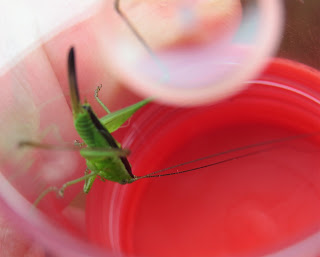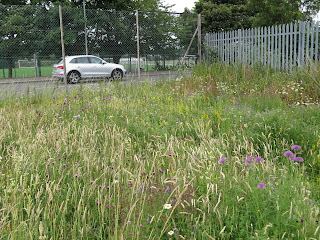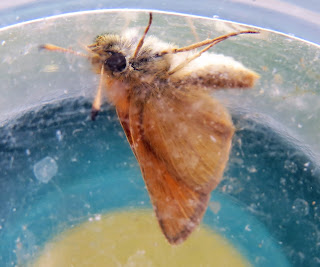 |
| Bug hunting at Mousehold Heath |
There was a bit of a thunderstorm this morning and the sky remained overcast afterwards. Not the kind of weather to join a group at Mousehold Heath this afternoon to look for insects, but thankfully the rain held out in the end. This was a guided walk led by butterfly expert Andy Brazil, who, along with his friend, were also very good with other insects, too. They were armed with nets, pots and magnifying glasses and looked like professional bug hunters from another era just with modern equipment.
 |
| The wildflower patch |
Our walk took us from Zak's car park to the closed off field near the golf course on the other side of the road. This field has been managed with wildflower borders along either end of a playing field. Now it is in bloom and just look at it! It is absolutely beautiful with a wide mix of wildflowers such as ox-eyed daisies, scabious, trefoils and many others, creating a mini landscape of blues, whites, greens and yellows. It is quite a contrast to the busy road running alongside it on the other side of the fence.
 |
| Essex Skipper |
Meadow brown butterflies were everywhere in these tiny pockets of wildflower and were chasing each other in spiralling aerial dances. Tiny blurs of orange fluttering over the various colours of the field betrayed the presence of large and Essex skippers, while the brighter orange of commas were seen in the bramble patches nearby as they sat on the leaves to sun themselves. We also saw a small tortoiseshell doing the same in the middle of the field.
 |
| Large Skipper |
 |
| Meadow Brown |
 |
| Comma |
 |
| Small Tortoiseshell |
 |
| Soldier Beetle |
It is amazing what you can find if you look carefully enough. Our group were finding all sorts of things hidden in the grass and on the leaves of other plants. The two professional bug hunters leading the group were doing their best in catching them and educating us about what they caught. The captured creatures were passed around the group, giving each of us a closer look. I learnt things I never knew before, such as sexing a fly. Apparently, if their eyes are close together, it is a male and if there is a gap between them, it is a female.
 |
| A young Ladybird emerging from it's pupa |
 |
| A freshly emerged fly (it's wings are not dried out yet) |
 |
| Burnet Moth Pupa |
 |
| Sawfly Larva |
So what were the main highlights? Well, for me, it had to be the sawfly larvae feeding on the tall stems of grass. They look just like caterpillars, but have more legs (in which most of them are fake) and the head looks slightly different. We also found a hornet hoverfly (a perfect mimicry of a hornet), marmalade hoverflies (which are migrants from France), thick-thighed flower beetles and plenty of moths, grasshoppers and crickets.
 |
| Marmalade Hoverfly |
 |
| Hornet Hoverfly |
 |
| Oak Bush-cricket |
 |
| Long-winged Cone-head |
 |
| Long-winged Cone-head |
 |
| Brown Silver-lines |
 |
| Buff-tailed Bumblebee |
 |
| Thick-thighed Flower Beetle |
 |
| Buff Ermine |
 |
| Bank Vole freeing itself from Bramble thorns |
On the way back, we came across this vole trying to free itself from the thorns of a bramble patch. It appeared to be impaled and was trying to wiggle and gnaw it's way to freedom. It looked painful, but thankfully it escaped after a couple of minutes of struggle. I was so glad it was ok as I was never going to risk my hand from being mauled by the vole in attempt to rescuing it myself.

 |
| White-letter Hairstreak egg |
While the group disbanded when we returned to the car park, a few of us remained a little while longer, discussing about wildlife with Andy. Meanwhile, the group's other bug hunter was busy searching the elm trees nearby. We were then called over when he found something very interesting attached to part of a twig on one of the trees. Now, if you look very carefully in this photo, can you see a tiny green disc in the centre of this twig? Believe it or not, that is an egg of a white-letter hairstreak butterfly! How on earth he saw that is beyond me, but according to him, this egg was laid fairly recently as they are normally much blacker in colour. What an incredible thing to find!

































No comments:
Post a Comment